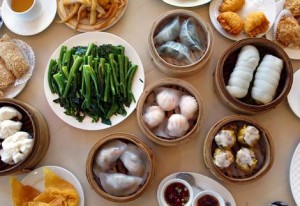
Yum cha is a term in Cantonese which literally means “drinking tea”. It refers to the custom of eating small servings of different foods while sipping Chinese tea in Cantonese speaking areas of southern China. It is an integral part of the culinary culture of Guangdong Province, Hong Kong and Macau. In any city with a sizeable population of Cantonese people, to yum cha is a tradition on weekend mornings, and whole families gather to chat and eat dim sum and drink Chinese tea. Yum cha is also a morning ritual for the elderly to spend a good part of the morning after early morning exercise of tai chi or a walk. The tea is important, for it is said to help digest the rich foods which are generally on offer. In the past, people went to a teahouse to yum cha, but dim sum restaurants have been gaining overwhelming popularity of late.
 The ritualised drinking of tea is often practised in China. The most important work on tea making is the Cha Jing. It is the only extant work of the Tang Dynasty scholar and poet Lu Yu and was written during the 800s BC. In this ancient text, Lu Yu describes many aspects of tea making from the location of the teahouse to the mode of drinking. His treatise is considered definitive by many.
The ritualised drinking of tea is often practised in China. The most important work on tea making is the Cha Jing. It is the only extant work of the Tang Dynasty scholar and poet Lu Yu and was written during the 800s BC. In this ancient text, Lu Yu describes many aspects of tea making from the location of the teahouse to the mode of drinking. His treatise is considered definitive by many.
In Northern Imperial China, teahouses were regarded as retreats for gentlemen and later for businessmen. Deals would be discussed and sealed in the neutral, relaxed surroundings of a teahouse rather than in offices. Teahouses were and are places where disputes could be settled harmoniously over tea. Courts of law are not spots where most people feel at ease. The Chinese at times replaced this setting with a teahouse and the presence of a mutually respected arbiter. The disputing parties would agree on terms and apologies, pay for the tea, shake hands and part in peace. In the same way that insurance agencies and stock brokerages in England developed out of simple coffee shops, teahouses in China were, and still are, used as places to conduct business.
Some teahouses in Hong Kong still uphold such a tradition and are frequented by Hong Kong Chinese industrialists and entrepreneurs. Traditional teahouses can still be found in the older communities. The most well-known example in Central is the Luk Yu Teahouse, a half-century-old living monument to the sedate stylishness of old Hong Kong. Stained-glass murals and massive framed scrolls decorate white walls. The teahouse’s original black ceiling fans spin idly in the air-conditioned rooms. Mirrored and marbled private wooden booths are conspiratorial businessmen’s havens. To go for yum cha at the Luk Yu is to enter a new era. It is best experienced mid-morning or mid-afternoon, outside the breakfast and lunch rush hours when every seat and table is usually reserved for regular customers. This very special teahouse is Hong Kong’s tribute to the 8th-Century tea master – Luk Yu being the Cantonese version of Lu Yu.
Yum Cha is also an occasion when families often gather to visit each other on the weekends, when everyone has time from their busy schedules. It may resemble, as a Chinese friend suggested, the Sunday brunch after church that is familiar to many religious Westerners. It is a time filled with catching up on what went on in each other’s lives in the past week and what the family plans are for the near future. Many Yum Cha restaurants, in their relaxing atmosphere, share some similarities with contemporary Western café culture, replete with frequenters of a “chatty” bend. But they offer diners an experience well beyond the fare found at most bagel-slinging mocha-slurping coffeehouses.
Yum Cha is also an occasion when families often gather to visit each other on the weekends, when everyone has time from their busy schedules. It may resemble, as a Chinese friend suggested, the Sunday brunch after church that is familiar to many religious Westerners. It is a time filled with catching up on what went on in each other’s lives in the past week and what the family plans are for the near future. Many Yum Cha restaurants, in their relaxing atmosphere, share some similarities with contemporary Western café culture, replete with frequenters of a “chatty” bend. But they offer diners an experience well beyond the fare found at most bagel-slinging mocha-slurping coffeehouses.
I try to have yum cha as regularly as possible. I love the atmosphere of busy Chinese restaurants, especially if they are full of Chinese people, as you know the food must be good. In every major city in Australia, you will find yum cha restaurants, and the best I’ve been to are in Melbourne and Sydney, but Brisbane is now boasting some great yum cha venues these days also. Try it one weekend, but go there hungry, as there’s so many great dishes to try … and beware! … it’s quickly filling. Bon appetite!
